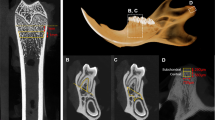Summary
The status of bone mineral and osteocalcin in the young adult Rhesus monkey mandible was assessed following a 14-day period of postcranial immobilization, and after 7- and 28-day recovery periods. Specimens of cortical bone taken from the compact bone at the inferior border of the jaws were ground in liquid nitrogen and sieved to a particular size below 20 μm. The bone powder was then fractionated in a bromoform-toluene density gradient to determine its mineralization profile (Ca, P, CO3, and osteocalcin), and X-ray diffraction was used to determine apatite crystal size in some fractions. There was no change in the chemistry of the mandibular bone from the immobilized animals. However, the mineralization profile in that group showed a significant shift toward the higher density fractions, indicating the presence of a greater than normal content of mature well-mineralized bone. While this trend was accentuated in the jaws following a 7-day postimmobilization recovery period, partial recovery of the normal profile was observed after a 28-day recovery period. The osteocalcin profile shifted like the mineralization profile during the immobilization and recovery periods. X-ray diffraction analyses showed that the shift in the mineralization profile during the immobilization period was associated with a decrease in apatite crystal size.
Similar content being viewed by others
References
Donaldson CL, Hulley SB, Vogel JM, Hattner RS, Bayers JH, McMillan DE (1970) Effect of prolonged bedrest on bone mineral. Metabolism 19:1071–1084
Minaire P, Meunier PJ, Edouard C, Bernard J, Coupron P, Borret J (1974) Quantitative histological data on disuse osteoporosis. Calcif Tissue Res 17:57–73
Cann CE, Genant HK, Young DR (1980) Comparison of vertebral and peripheral mineral losses in disuse osteoporosis in monkeys. Radiology 134:525–529
Uhthoff HK, Jaworski ZFG (1978) Bone loss in response to long-term immobilization. J Bone Joint Surg 60B:420–429
Rambaut PC, Johnston RS (1979) Prolonged weightlessness and calcium loss in man. Acta Astronautica 6:1113–1122
Wronski TJ, Morey ER (1982) Skeletal abnormalities in rats induced by simulated weightlessness. Metab Bone Dis Rel Res 4:69–75
Young DR, Niklowitz WJ, Steele CR (1983) Tibial changes in experimental disuse osteoporosis in the monkey. Calcif Tissue Int 35:304–308
Simmons DJ, Russel JE, Walker WV, Grazman B, Oloff C, Kazarian L (1984) Growth and maturation of mandibular bone in otherwise totally immobilized Rhesus monkeys. Clin Orthop Rel Res 182:220–230
Bonar LC, Roufosse AH, Sabine WK, Grynpas D, Glimcher MJ (1983) X-ray diffraction studies of the crystallinity of bone mineral in newly synthesized and density fractionated bone. Calcif Tissue Int 35:202–203
Klug HP, Alexander LE (1974) X-ray diffraction procedures for polycrystalline and amorphous materials, 2nd ed. John Wiley and Sons, New York, pp. 687–692
Jones JW, Caspar SG, O'Haver TC (1982) Critical evaluation of a multi-element scheme using plasma emission and hydride evolution atomic absorption spectrometry for the analysis of plant and animal tissues. The Analyst 107:353–377
Hirschman A, Sobel AE (1965) Composition of the mineral deposited during in vitro calcification in relation to the fluid phase. Arch Biochem Biophys 110:237–243
Hauschka, PV, Carr SA, Biemanan K (1982) Primary structure of monkey osteocalcin. Biochemistry 21:638–642
Patterson-Allen PE, Brautigan CE, Grindeland RE, Esling CW, Callahan TX (1982) A specific radioimmunoassay for osteocalcin with advantageous species cross-reactivity. Anal Biochem 120:1–7
Patterson-Allen P, Globus R, Halloran B, Bikle D, Cann C, Morey E (1984) Relation of serum osteocalcin and 1,25 dihydroxyvitamin D3 to bone formation during skeletal unloading. Calcif Tissue Int 36:468
Wronski TJ, Morey ER (1983) Inhibition of cortical and trabecular bone formation in the long bones of immobilized monkeys. Clin Orthop 181:269–276
Author information
Authors and Affiliations
Rights and permissions
About this article
Cite this article
Grynpas, M.D., Patterson-Allen, P. & Simmons, D.J. The changes in quality of mandibular bone mineral in otherwise totally immobilized Rhesus monkeys. Calcif Tissue Int 39, 57–62 (1986). https://doi.org/10.1007/BF02553291
Received:
Revised:
Issue Date:
DOI: https://doi.org/10.1007/BF02553291




